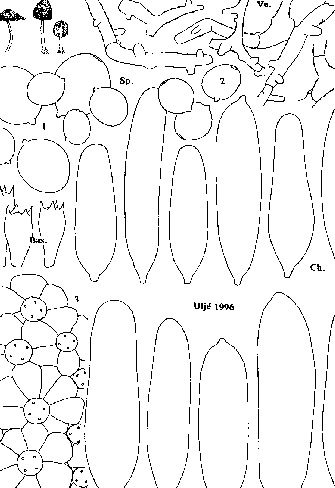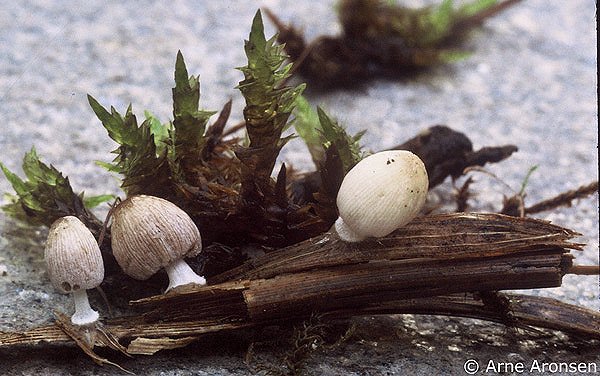|
 Pileus 3-6(-10) x 2.5-5(-8) mm when still closed, up to 10(-18) mm when expanded, first subglobose, ellipsoid or ovoid and ochre-brown (K. & W. 6E5) or mocha brown, soon becoming pale grey to grey, covered with minute flocculose veil. Lamellae, L = c. 34, l = 1-3, free, first white to beige, than grey-brown to dark grey, finally black. Stipe up to 30 x 0.5-1.5 mm, white, minutely fibrillose-floccose, later glabrous; base bulbous, with tomentose, basal disk. Pileus 3-6(-10) x 2.5-5(-8) mm when still closed, up to 10(-18) mm when expanded, first subglobose, ellipsoid or ovoid and ochre-brown (K. & W. 6E5) or mocha brown, soon becoming pale grey to grey, covered with minute flocculose veil. Lamellae, L = c. 34, l = 1-3, free, first white to beige, than grey-brown to dark grey, finally black. Stipe up to 30 x 0.5-1.5 mm, white, minutely fibrillose-floccose, later glabrous; base bulbous, with tomentose, basal disk.
Spores [440,22,19] 6.8-11.7 x 6.2-10.4 µm, subglobose or broadly ellipsoid, rounded at apex or slightly acute, medium to dark red-brown, with central to slightly eccentric, 1.3-1.6 µm wide germ pore, which is often difficult to observe; Q = 1.00-1.35, av. Q = 1.05-1.25; av. L = 8.1-10.7, av. B = 7.5-9.2 µm. Basidia 14-36 x 8-11.5 µm, 4-spored, surrounded by 5-8 pseudoparaphyses. Pleurocystidia 55-110(-200) x 12-20(-28) µm, utriform or (sub)cylindrical. Cheilocystidia 35-80(-120) x 11-20(-28) µm, (narrowly) utriform, (sub)cylindrical or conical. Elements of veil thin-walled, diverticulate, 2-6 µm wide. Clamp-connections present.
|
Habitat & distribution |
Solitary or a few together on dead Phragmites, Juncus and Carex, in greenhouses on rich soil and rotten straw. Rare, but probably overlooked. Europe, but probably also in other regions. |
Remarks |
The colour, size of the basidiocarps, habitat and the subglobose spores are characters to identify Coprinus kubickae (for discussion see under C. kimurae).
In greenhouses the basidiocarps become larger (see sizes between parentheses), as do the pleuro- and cheilocystidia. |

 Pileus 3-6(-10) x 2.5-5(-8) mm when still closed, up to 10(-18) mm when expanded, first subglobose, ellipsoid or ovoid and ochre-brown (K. & W. 6E5) or mocha brown, soon becoming pale grey to grey, covered with minute flocculose veil. Lamellae, L = c. 34, l = 1-3, free, first white to beige, than grey-brown to dark grey, finally black. Stipe up to 30 x 0.5-1.5 mm, white, minutely fibrillose-floccose, later glabrous; base bulbous, with tomentose, basal disk.
Pileus 3-6(-10) x 2.5-5(-8) mm when still closed, up to 10(-18) mm when expanded, first subglobose, ellipsoid or ovoid and ochre-brown (K. & W. 6E5) or mocha brown, soon becoming pale grey to grey, covered with minute flocculose veil. Lamellae, L = c. 34, l = 1-3, free, first white to beige, than grey-brown to dark grey, finally black. Stipe up to 30 x 0.5-1.5 mm, white, minutely fibrillose-floccose, later glabrous; base bulbous, with tomentose, basal disk.